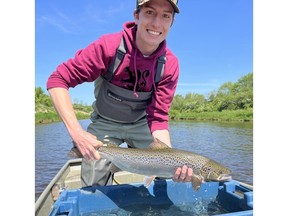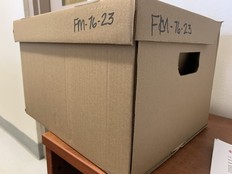Salmon are reproducing in the Petitcodiac River: report
Researchers say juvenile salmon are following adult females around the river for a chance to fertilize their eggs

Article content
Replacing the old causeway with a bridge and restoring the flow of the Petitcodiac River has resulted in stronger tides and a better environment for many species of fish that live in the river system, says the latest report from the Fort Folly Habitat Recovery Program.
“Tides this year (2023) have been stronger than they have ever been, as they have year after year since the opening of the new bridge, and I expect that to continue to happen,” said Edmund Redfield, manager of the Fort Folly Habitat Recovery program.
The program released its report on the 2023 season this week, which indicated an improvement for many species of fish in the river, but so far they haven’t found wild Atlantic Salmon that returned to the river from the ocean to spawn. The 2023 season was the 14th year of monitoring diadromous fish (those which migrate between salt and fresh water) as part of the province’s Petitcodiac River Restoration Project. They set up a trap on the river near Salisbury in on May 23 and operated it for the full season. Their report is based on the research done at the trap in 2023.
Redfield said the change in tides have definitely helped fish like striped bass and eels, which move through the river system. The new $61-million bridge was opened to traffic in September, 2021, and officially named for the late Senator Brenda Robertson in 2023.
The report said the average tidal amplitude (1.71 metres) at the railway bridge in Salisbury was 57 centimetres higher in 2023 than 2022.

Salmon have also benefitted from the free-flowing river, which is no longer considered an obstructed waterway and eligible for federal research funding. The return of one wild Atlantic Salmon right after the opening of the bridge was a beacon of hope. Researchers have been trying to figure out for years why salmon are leaving river systems where they were born and venturing out into the ocean, but not returning to their home to lay eggs.
“I doubt that we would have gotten that fish if it had to go through the control structure of the old causeway,” he said. During the gaspereau run in May and June, the fish are followed by hungry bald eagles, osprey and even seals that have been seen in the Pollett River.

“One thing that we’d never seen before this year was a large number of juvenile salmon, precocious parr, which are seeking out adults that we released in 2022. The fact that the juvenile salmon were responding so strongly was definitely a new thing,” he said.
He said these juvenile male salmon, who were born on the river but haven’t gone out to sea, follow the female salmon around, waiting for the females to drop their eggs so they can fertilize them with sperm.
“The fact that these fish are reproducing before they go out to sea gives them better odds of reproducing than if they went out to sea and came back themselves,” he said.
Female salmon who go out to see and feed will grow larger and have more eggs, then return to their river to lay their eggs. Sometimes they will create a nest and release hormones to attract strong males to fertilize them. But the juvenile males will follow around the edges to fertilize any eggs the larger males missed. Having more males around means that more eggs are fertilized and grow into adult fish that maintain the population.
“This is a sign that our stocking efforts have brought the population up such that there are juveniles who are capable of participating in this way,” Redfield said. “A few years ago, you’d put adults in and there weren’t substantial numbers of juveniles who could participate. That’s an indication of what our stocking efforts have done. Otherwise, you would have a lot of eggs that go unfertilized.”
Redfield said the number of gaspereau found in the river in 2023 increased. He believes this is because water temperatures are increasing gradually due to climate change. An increase in water temperature triggers the fish to make their move up the river, and it is happening earlier each year.
The report says the Fort Folly program caught a total of 4,201 fish and 3,887 of them were gaspereau.
Other fish caught for study in the trap near Salisbury were brook trout (6), striped bass (27), Inner Bay of Fundy Atlantic Salmon (16), white sucker (188), white perch (13), common shiners (51), three spine stickleback (2), mummichog (2), brown bullhead (5) and one gold fish.
The researchers also encountered several muskrats who got caught in the traps and chewed their way through to escape.












Postmedia is committed to maintaining a lively but civil forum for discussion. Please keep comments relevant and respectful. Comments may take up to an hour to appear on the site. You will receive an email if there is a reply to your comment, an update to a thread you follow or if a user you follow comments. Visit our Community Guidelines for more information.